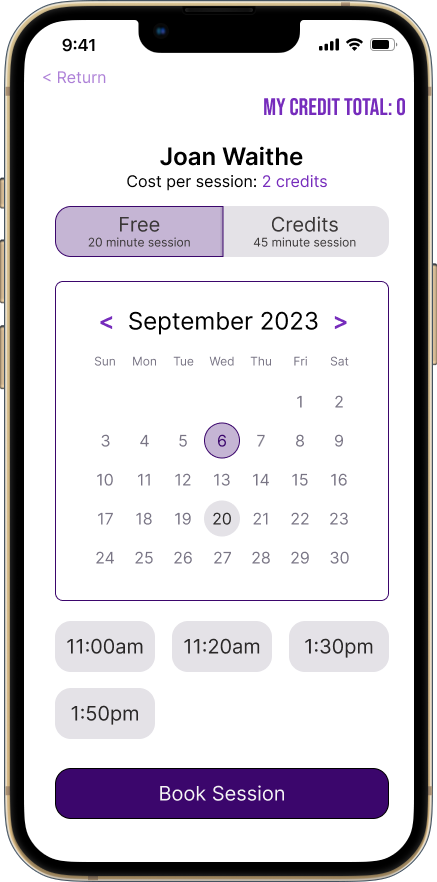Wevolv
Thinking outside the brief for solutions
The Project
Name
Wevolv
via Harness Projects
Role
UX Designer & Researcher
Time
6 Weeks
The Goal:
Enhance the user experience of the Wevolv mobile app, focusing on player tracking and endorsements.
Who is Wevolv?
“Wevolv is an on and off-line platform founded and designed by professional athletes that provides validated, intelligent data and resources to athletes around the globe, empowering them to make better decisions and inspiring them to advance the industry.”
Empathizing and Defining the Problem
Stakeholder Needs
Good design starts with good research. In our stakeholder interview we learned the needs and goals of Wevolv. These are . . .
to have a global reach but feel personal to each athlete around the world
to be tapped into the niche cultures of each individual sport
to provide access to information that is hard to find elsewhere (i.e. contract review, advice on life abroad)
to be a place for athletes to receive unbiased opinions on their careers
to help athletes abroad avoid isolation in their new surroundings
After the interview, I came back to Wevolv's mission statement and homed in on the idea of empowerment. How could our brief, which was based around scheduling and endorsements, harness these features as tools of empowerment.
HOW MIGHT WE empower athletes through the use of Wevolv?
Mission Statement
“ Assemble a global collective of athletes and empower them to make better decisions, build community and create impact.
Rethinking
When answering these questions, I kept coming back to how certain actions (for example, having competitive elements in an app to help further careers that are already inherently competitive) and the focus on gamification might affect an athlete's mental health. Through this I noticed a gap in the platform's offerings and an opportunity that might solve our How Might We in a more direct way.
Ideating Solutions
During the stakeholder interview, Jori, gave us permission to go off-brief and follow the paths that we thought would be most helpful to Wevolv.
My off-brief solution to solving our How Might We?
A mental health and wellness portal on the app where athletes can easily find resources and engage in beneficial practices.
I chose to home in and prioritize the Mentor Support feature. Places like ADPList, which is for the tech industry, have successfully collected large groups of mentors excited to give their time to help others in their field.
Benefits of Mentor Support
For Wevolv:
Platforms members already there as a resourse
Additional revenue
For Members
Personalized support
Pricing Options
For Mentors
Career Development
Income
I chose to demonstrate a credit-based system, that allows athletes to subscribe to credits, as well as allows mentors to decide on how much they want to charge per session.
Flexibility in options and scheduling like on Calendly
Gives mentors autonomy in how they give and run their time
Gives athletes a variety of options to choose from based on their ability and needs
Testing
Interview and Moderated Usability Test
Professional basketball player in Sweden
Interview and Interactive Prototype
Highlighted the desire to be able to speak to someone who has been in her shoes
Coming from a country with free healthcare, finding medical help when needed is not a big issue. But being able to reach out to someone who understands the ins and outs of this very unique world is invaluable
“In Sweden we have a lot of free health care . . . but like, since [Wevolv] is so specialized, you can really find someone that can . . . really help you with what you need . . .for a one hour session, I would definitely be up to paying like, $30 or euros.”
— 22 F, Sweden, Basketball Player
Usability Test (vis Usability Hub- now Lyssna)
Details:
Unmoderated
30 Participants
4 Tests
Prototype Tasks:
Mentor search
Session booking
Credit purchase
Key Takeaways
Keep it Simple
Use direct and easy to define labels
Visual Clarity
Clearly define button status
Decreases user frusturation
Prototype
I focused on making button and credit status clear to avoid misclicks and confusion in scheduling
I have included an option for mentors to add a voice note to introduce themselves.
My interviewee mentioned wanting someone who is "good at talking." So, someone not only relatable on paper but can also communicate well during their sessions.
A voice message is a great way for an athlete to get a better sense of a mentor's personality.
Final Thoughts and Feedback
Moving Forward
Home in on what areas athletes are most looking to gain insight on through mentors using surveys and interviews
Interview potential mentors on what would motivate them to participate and how they envision incorporating this kind of work into their life
Stakeholder Feedback
“I really liked the detail on your provider cards when the player is searching. That was great.”
“I like the credit system, I think it also sets us up to really open up the door for other ways to get credits without paying, which is something that is a gamified element the user can give in other ways. . . I think that's definitely that triggered that thought of ‘Oh, great, yes, that's a way we can help.’ You can give in other ways to gain credits, or you can just pay for them.”
“ [This] helps us with phase two, and kind of clears up and brings some clarity around things we get implement for that . . . Finding another word for mentor has been something we've also thought about from the beginning because mentorship we felt is something like a longer-term commitment.”
If I were continuing on this project, this would be a great jumping off point for further research. What wording best sets up engagement with this offering?









